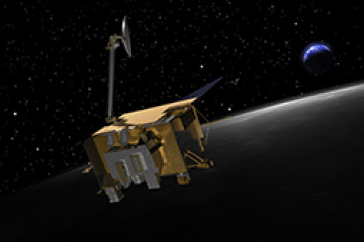The University of New Hampshire is a flagship research university that inspires innovation and transforms lives in our state, nation and world. More than 16,000 students from all 50 states and 71 countries engage with an award-winning faculty in top ranked programs in business, engineering, law, health and human services, liberal arts and the sciences across more than 200 programs of study. UNH’s research portfolio includes partnerships with NASA, NOAA, NSF and NIH, receiving more than $100 million in competitive external funding every year to further explore and define the frontiers of land, sea and space.
UNH Researchers Find Space Radiation is Increasingly More Hazardous

Caption: Artist’s rendition of the Lunar Reconnaissance Orbiter at the moon. The CRaTER telescope is seen pointing out at the bottom right center of the LRO spacecraft. Photo credit: NASA's Goddard Space Flight Center Conceptual Image Lab
DURHAM, N.H. – It might sound like something from a science fiction plot – astronauts traveling into deep space being bombarded by cosmic rays – but radiation exposure is science fact. As future missions look to travel back to the moon or even to Mars, new research from the University of New Hampshire’s Space Science Center cautions that the exposure to radiation is much higher than previously thought and could have serious implications on both astronauts and satellite technology.
“The radiation dose rates from measurements obtained over the last four years exceeded trends from previous solar cycles by at least 30 percent, showing that the radiation environment is getting far more intense,” said Nathan Schwadron, professor of physics and lead author of the study. “These particle radiation conditions present important environmental factors for space travel and space weather, and must be carefully studied and accounted for in the planning and design of future missions to the moon, Mars, asteroids and beyond.”
In their study, recently published in the journal Space Weather, the researchers found that large fluxes in Galactic Cosmic Rays (GCR) are rising faster and are on path to exceed any other recorded time in the space age. They also point out that one of the most significant Solar Energetic Particle (SEP) events happened in September 2017 releasing large doses of radiation that could pose significant risk to both humans and satellites. Unshielded astronauts could experience acute effects like radiation sickness or more serious long-term health issues like cancer and organ damage, including to the heart, brain, and central nervous system.
In 2014, Schwadron and his team predicted around a 20 percent increase in radiation dose rates from one solar minimum to the next. Four years later, their newest research shows current conditions exceed their predictions by about 10 percent, showing the radiation environment is worsening even more than expected.
“We now know that the radiation environment of deep space that we could send human crews into at this point is quite different compared to that of previous crewed missions to the moon,” says Schwadron.
The authors used data from CRaTER on NASA’s Lunar Reconnaissance Orbiter (LRO). Lunar observations (and other space-based observations) show that GCR radiation doses are rising faster than previously thought. Researchers point to the abnormally long period of the recent quieting of solar activity. In contrast, an active sun has frequent sunspots, which can intensify the sun’s magnetic field. That magnetic field is then dragged out through the solar system by the solar wind and deflects galactic cosmic rays away from the solar system – and from any astronauts in transit.
For most of the space age, the sun’s activity ebbed and flowed like clockwork in 11-year cycles, with six- to eight-year lulls in activity, called solar minimum, followed by two- to three-year periods when the sun is more active. However, starting around 2006, scientists observed the longest solar minimum and weakest solar activity observed during the space age.
Despite this overall reduction, the September 2017 solar eruptions produced episodes of significant Solar Particle Events and associated radiation caused by particle acceleration by successive, magnetically well-connected coronal mass ejections. The researchers conclude that the radiation environment continues to pose significant hazards associated both with historically large galactic cosmic ray fluxes and large but isolated SEP events, which still challenge space weather prediction capabilities.
The research was funded by the CRaTER project and the LRO program (Contract No. NNG11PA03C), EMMREM (grant number NNX07AC14G), C-SWEPA (NASA grant number NNX07AC14G), Sun-2-Ice (NSF grant number AGS1135432) projects, DoSEN (NASA grant NNX13AC89G), DREAM2 (NASA grant NNX14AG13A), NASA STTR Phase 1 and 2 (A Coupled System for Predicting SPE Fluxes, Contract NNX15CG52P).
Latest News
-
November 22, 2024
-
November 7, 2024
-
October 30, 2024
-
October 10, 2024
-
October 8, 2024


















































